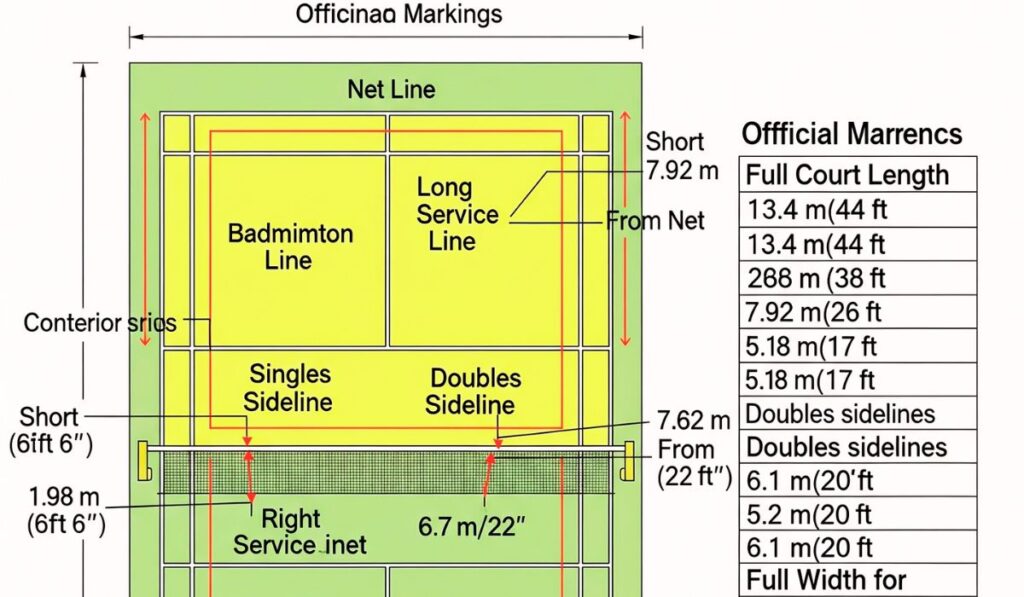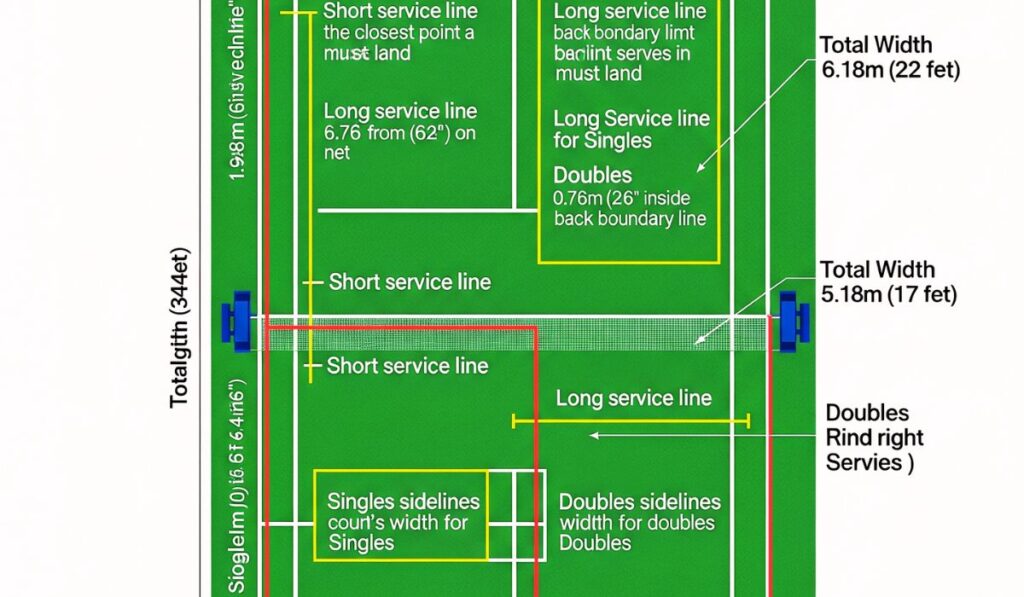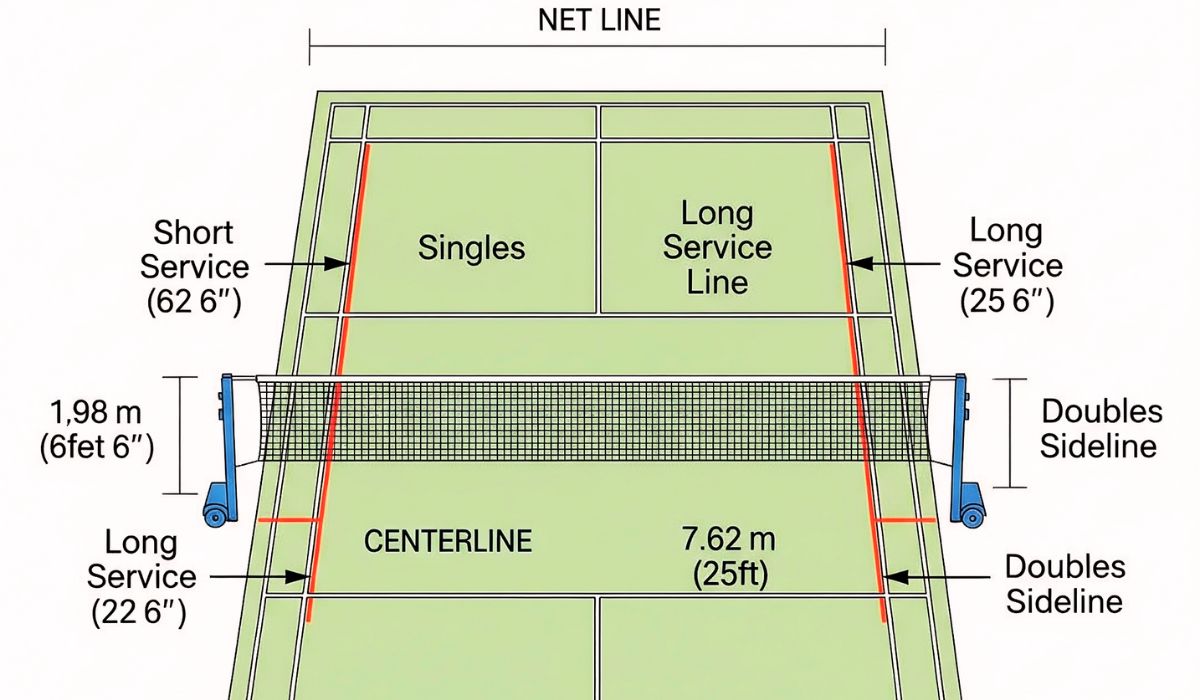The Shocking Mistakes in Badminton Court Layout – And the Powerful Guide That Shows Every Line, Label, and Secret
When you step onto a badminton court, you might think it’s just a rectangular floor with a net in the middle. But in reality, every inch of that court holds meaning, precision, and hidden strategy. Each line is not randomly drawn — it’s a silent language of the sport. A well-marked badminton court with labels is more than a surface to play on; it’s the very stage where victories are scripted and defeats are carved into memory. Unfortunately, many players, even experienced ones, misunderstand or neglect the importance of these court markings, costing them points, matches, and sometimes their confidence.
In this detailed, human-written guide, we will dive into the intricate beauty of a badminton court with labels — not just to explain the lines, but to bring them alive for you. We’ll uncover how each marking influences the way you play, the psychology of positioning, and the thrill of knowing exactly where you stand. Imagine stepping onto the court and feeling a quiet surge of power, because you know every boundary, every danger zone, and every opportunity space. This is the emotional connection every true player must have with the court.
Why Knowing Your Court Labels Is a Game-Changer
A badminton court is not just a surface — it’s a map of possibility. Without the right understanding of its layout, you risk stepping out of bounds at crucial moments or misjudging where to serve. Knowing your badminton court with label details turns uncertainty into strategy. The dimensions, service lines, and center marks are your invisible allies, guiding every move.
But here’s the sad truth — many amateur players treat the court as a background rather than a tool. They focus on their shots but not their position. That’s like sailing without knowing the shoreline — you might move fast, but you’re lost. On the other hand, players who master the court markings gain a massive advantage. They serve with precision, defend with awareness, and attack with confidence because they are grounded in spatial intelligence.
Breaking Down the Badminton Court with Labels
Let’s visualize the court from top to bottom — almost like peeling back the layers of a masterpiece. The badminton court with labels consists of several critical parts:
- Baselines – These are the back boundaries for both singles and doubles play. Standing close to them during a smash feels thrilling because you’re right on the edge of safety and risk.
- Sidelines – These mark the left and right boundaries. Singles sidelines are closer in, demanding accuracy, while doubles sidelines expand your battleground.
- Center Line – Divides the service courts, dictating the precision of your serve.
- Short Service Line – The lifeline for a legal serve, making you balance between caution and aggression.
- Long Service Line (for doubles) – A special boundary that can surprise players if they don’t adjust their depth.
- Net Line – The heart of the court where anticipation and quick reflexes dominate.
Each of these lines is more than paint — they’re like the veins of the sport, channeling the flow of every rally.
The Emotional Power of the Badminton Court Layout
Imagine standing at the baseline, your fingers tightening on the racket, the silence before the shuttle soars toward you. You glance at the sidelines, the service lines — your eyes tracing the borders of the battlefield. Knowing them is like knowing the edges of your own heartbeat. This is not just about avoiding faults; it’s about transforming the court into your partner. Every label on the court whispers strategies, tells you when to attack, when to defend, and when to risk it all.
Singles vs. Doubles: How the Labels Change the Game
Here’s where many players fail — they don’t adapt to the shifting geometry between singles and doubles. In singles, the court narrows, making accuracy more critical. In doubles, it widens, demanding faster coverage. A badminton court with labels becomes two different worlds depending on the format. A player who doesn’t adjust might find themselves repeatedly out of position. But a player who knows how the sidelines expand or contract will dance across the court like they own every square inch.

The Sensory Appeal of a Perfectly Labeled Court
If you’ve ever walked into a freshly prepared court, you know the sensation — the crisp lines shining under the lights, the clean scent of the flooring, the quiet echo of your footsteps. The labels feel almost magnetic, pulling you into their structure. You feel the court before you even hit the first shot. This sensory connection matters because sport is not just about physical skill; it’s about the emotional atmosphere that fuels performance.
Common Mistakes Players Make with Court Awareness
Sadly, even talented players make these errors:
- Serving without aligning properly with the center line.
- Ignoring the doubles long service line and losing easy points.
- Stepping out during smashes because they misjudge the baseline.
- Standing too close to the sidelines, leaving huge open spaces for opponents.
These mistakes are not just technical — they are deeply psychological. A player who constantly crosses a line they shouldn’t begins to lose faith in their movement. That doubt is dangerous.
Turning Court Labels Into Your Competitive Edge
The secret is simple: awareness breeds confidence. When you truly master the badminton court with label, you play with a quiet authority. You know where the shuttle will land even before it hits the floor. You know where to stand so your opponent has no easy target. And you know how to use every legal inch of space to your advantage.
A well-marked court is a visual playbook. The moment you see where your opponent stands, you can instantly predict their limitations and exploit them — sometimes without them even realizing it.
The Science of Court Positioning
Sports scientists agree: spatial awareness boosts performance. In badminton, this means understanding not just where the lines are, but how to use them for deception, angles, and movement efficiency. By studying a badminton court with labels, you learn how to set traps for your opponent, lure them out of position, and strike when they’re vulnerable.
Understanding the Beauty of a Badminton Court with Labels
When you step onto a badminton court, it’s not just a space with lines—it’s a carefully designed stage for thrilling rallies, strategic moves, and unforgettable moments. A badminton court with labels transforms the experience entirely, guiding players with visual clarity, enhancing understanding, and offering a professional feel that sparks motivation. For a beginner, those labels can be a lifeline, pointing out where the service area begins, where the net stands tall, and where victory is claimed. For professionals, they serve as a constant reminder of boundaries, helping them make split-second decisions without second-guessing.
Why a Labeled Badminton Court Feels Different
Imagine walking into two courts—one plain, and one where every section is clearly marked with crisp, precise labels. The latter immediately gives you a sense of order, confidence, and readiness. Your eyes instinctively scan the markings, mentally preparing you for the game ahead. badminton court with label and The boundaries aren’t just painted—they’re telling you a story: the challenge of the backcourt, the pressure of the service line, the temptation to smash across the sidelines. A badminton court with labels isn’t just functional—it’s emotionally engaging.
Perfect Court Dimensions for a Flawless Game
An international standard badminton court with label measures 13.4 meters in length and 6.1 meters in width for doubles, while the singles court narrows to 5.18 meters. A labeled court takes these standard dimensions and elevates them—making it easier for players to recognize their playing zones instantly. Every service line, every side boundary, and every center marking comes alive when labeled, removing confusion during intense rallies.
Breaking Down the Labeled Sections
A professional badminton court with labels usually highlights:
- Baselines – Indicating the farthest back boundary.
- Sidelines for Singles and Doubles – Marking the width difference between game formats.
- Service Lines – Helping servers stand in the correct position every time.
- Center Line – Dividing the service courts for precision placement.
- Net Line – Reminding you of the critical midcourt battle zone.
By labeling these sections, both training and competition become smoother and more precise.
Training Advantages of Labeled Courts
For coaches and trainers, a badminton court with labels is like having a built-in assistant. Instead of constantly stopping the game to point out mistakes, they can simply refer to the labeled zones: “Stay behind the service line,” or “Push towards the doubles sideline.” This speeds up learning and creates an environment where beginners adapt faster and advanced players polish their positioning with ease.
Psychological Impact of a Well-Labeled Court
There’s a subtle psychological edge to playing on a court with labels. Clear boundaries reduce uncertainty, allowing players to focus on strategy rather than second-guessing positions. It builds confidence, encourages risk-taking in shots, and fosters a sense of professionalism. You’re not just playing; you’re performing in an arena designed for excellence.
Materials and Labeling Techniques
Labels on badminton court with label can be applied in several ways:
- Painted Labels – Permanent, vibrant, and ideal for professional courts.
- Vinyl Stickers – Flexible and replaceable, great for training spaces.
- Embedded Markers – Durable, built into the flooring for long-term use.
Choosing the right labeling method depends on whether the court is indoors, outdoors, or used primarily for competitive matches.
How Labels Help in Tournaments
In competitive matches, even the smallest misstep can cost a point. Labeled courts minimize disputes about positions and service faults. Umpires, line judges, and players all benefit from the instant clarity. The labels serve as silent referees—always visible, always correct.
Creating an Immersive Playing Atmosphere
Playing on a labeled badminton court with label is more than just technical—it’s sensory. The bright contrast of the lines against the flooring catches your eye with every movement. The feel of stepping into clearly defined areas sharpens your instincts. You start anticipating shots differently, making you more aggressive when needed and more defensive when necessary.

The Soul of a Badminton Court – More Than Just Lines and Labels
When you step onto a badminton court with label for the first time, your senses awaken. The crisp smell of polished wood or the faint rubbery scent of synthetic flooring seeps into your memory. But beneath this sensory pleasure lies a precise science — every line, every label is a silent rule of the game. A badminton court with labels is not just about structure; it’s about storytelling. The service lines whisper about perfect serves, the sidelines murmur about agility, and the net stands tall, demanding respect. Understanding these elements transforms you from a casual player into someone who feels the heartbeat of the game.
Why Labels Matter More Than You Think
Labels are not decorative stickers. They are the visual language of badminton. Each labeled line carries authority — a gentle yet firm reminder that every point begins and ends with precision. The baseline, the center line, the short service line — they work in harmony to create a space where fair play thrives. Without clear labels, disputes rise, gameplay slows, and frustration replaces enjoyment. For both beginners learning their first rally and professionals playing for glory, a badminton court with accurate labels is the foundation of trust in the sport.
The Seductive Geometry of a Perfect Court
If you take a moment to trace the layout of a badminton court with label with your eyes, you’ll notice how the lines carve beauty into symmetry. The rectangular shape, the balanced left and right halves, the harmonious distances — it’s a design that marries elegance and function. Each measurement isn’t random; it’s a number forged by decades of sport evolution. Standing at the backline, gazing at the net with the labeled zones neatly outlined, you feel like an artist about to paint a masterpiece — every shot a brushstroke, every rally a moving canvas.
From Chalk Dust to Laser Lines – The Evolution of Court Labeling
Once upon a time, badminton court with label were marked with chalk, the powdery trails smudging after intense matches. Players would wipe sweat and chalk off their shoes, smiling at the imperfection. Today, modern courts use permanent paint, adhesive vinyl, or even laser-projected labels for high-tech arenas. This evolution has elevated accuracy and reduced maintenance, making badminton courts with labels more durable and professional-looking. Yet, there’s a nostalgic romance in those fading chalk lines — a reminder that even in sport, tradition holds charm.
The Emotional Comfort of Familiar Labels
Every player has that one badminton court with label where they’ve tasted victory, endured defeat, and learned resilience. For many, the labeled zones become landmarks of memory. You remember the spot on the right service court where you hit your first smash winner, or the left baseline where you served an ace. Labels don’t just guide play — they anchor your personal badminton story. They are silent witnesses to your growth, urging you to return, play again, and chase that perfect rally.


2 thoughts on “badminton court with label”